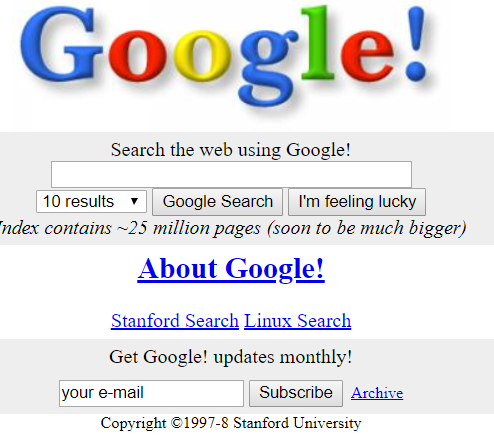Google is a prime example of a company that has successfully navigated the ever-changing technology landscape, growing from a small search engine startup to a global tech powerhouse. Its journey from humble beginnings to becoming one of the most valuable brands in the world offers key insights into innovation, business strategy, and adaptability. This case study explores the key factors behind Google’s success, examining how the company has maintained its position at the forefront of the digital revolution.
Google's First Office: The garage where Google actually started
Background: The Birth of a Search Engine
Google was founded in 1998 by Larry Page and Sergey Brin, two Stanford University Ph.D. students with a vision to improve the way people find information online. At the time, the internet was growing rapidly, but search engines struggled to provide relevant, accurate results. Google’s revolutionary PageRank algorithm changed the game by ranking websites based on their importance and relevance, providing users with the best possible results for their queries.
The core idea behind PageRank was simple: websites that are linked to by many other relevant sites should rank higher. This approach prioritized quality and relevance over mere keyword matching, giving Google a significant competitive advantage over other search engines like Yahoo and AltaVista. By focusing on user needs and delivering a superior search experience, Google quickly gained popularity.
Key Factors Behind Google’s Success
1. Relentless Focus on User Experience
One of the primary reasons for Google’s success is its unwavering commitment to the user. From the beginning, Google prioritized a clean, minimalist interface that was free of ads and distractions, allowing users to focus solely on their search queries. This user-first approach not only attracted users but also kept them coming back.
Unlike competitors that cluttered their homepages with various services, Google remained laser-focused on its core offering: delivering fast, accurate search results. This attention to user experience extended to every product and service Google introduced, creating a strong foundation of trust and loyalty among its users.
2. Innovative Business Model: Google Ads
Google Ads transformed the company’s revenue potential, turning it into an advertising giant. Today, Google Ads accounts for the majority of Google’s revenue, generating billions of dollars annually and funding the company’s continuous innovation and expansion into new areas.
3. Expansion into a Global Ecosystem
Google’s ability to expand beyond search has been another crucial factor in its success. The company built an ecosystem of products and services that serve as touchpoints in nearly every aspect of the digital experience. Some key milestones include:
- Gmail (launched in 2004): A free, web-based email service that quickly gained popularity due to its user-friendly interface and large storage capacity.
- Google Maps (launched in 2005): Revolutionized navigation with its digital mapping service, offering real-time directions and local business information.
- Google Chrome (launched in 2008): A fast, lightweight web browser that quickly gained market share and became the most popular browser globally.
- Android (acquired in 2005): Google entered the mobile operating system market with Android, now the world’s most widely used mobile OS.
- YouTube (acquired in 2006): A strategic acquisition that helped Google dominate online video and digital media.
Each of these services complemented Google’s core search engine, creating a cohesive ecosystem that kept users within Google’s orbit for all their digital needs.
4. Mastery of Data and Artificial Intelligence
Google’s success has also been driven by its unmatched ability to harness data. The company collects vast amounts of data from user interactions across its platforms, which it uses to refine algorithms, improve services, and offer highly targeted advertising.
Google’s investments in artificial intelligence (AI) and machine learning have further fueled its growth. AI powers many of Google’s most innovative features, from predictive search suggestions to advanced capabilities in Google Assistant, Google Photos, and Google Translate. By leveraging AI, Google continues to stay ahead of competitors, offering cutting-edge solutions to complex problems.
5. Culture of Innovation
At the heart of Google’s success is its culture of innovation. Google has always fostered an environment where experimentation and creative problem-solving are encouraged. Its famous "20% time" initiative, which allowed employees to spend 20% of their time working on projects outside of their regular responsibilities, led to the creation of some of Google’s most successful products, such as Gmail and Google News.
This culture has been key to Google’s ability to adapt and evolve in an industry that moves at breakneck speed. Google continually reinvests in research and development (R&D), ensuring it remains on the cutting edge of new technologies, from cloud computing to quantum computing.
6. Acquisition Strategy
Another factor that has contributed to Google’s success is its strategic acquisitions. Rather than relying solely on internal innovation, Google has aggressively acquired companies that complement its vision. Some of its most notable acquisitions include:
- YouTube (2006): Now the dominant platform for online video content.
- DoubleClick (2008): Boosted Google’s advertising capabilities.
- Android (2005): Helped Google dominate the mobile operating system market.
- Nest (2014): Expanded Google’s presence in smart home technology.
These acquisitions allowed Google to enter new markets and stay ahead of industry trends, while also integrating these new technologies into its existing ecosystem.
Challenges and Criticisms
To address these issues, Google has taken steps to improve transparency and offer users more control over their data. The company has also diversified its revenue streams to reduce reliance on advertising, expanding into areas such as cloud computing, hardware (with products like Google Pixel), and AI-driven solutions for businesses.
Conclusion: A Formula for Long-Term Success
Google’s success story is a testament to the power of innovation, user focus, and adaptability. By consistently delivering value to users through high-quality products and services, Google has built a brand that is trusted and relied upon by billions around the world. Its ability to innovate, scale, and maintain a user-centric approach has ensured its place at the top of the tech industry.
As Google continues to evolve, expanding into new fields like AI, quantum computing, and sustainability initiatives, its success formula—rooted in data, user experience, and bold innovation—will likely remain its guiding force. The company's journey from a search engine to a global technology leader provides valuable lessons for businesses of all sizes looking to succeed in the digital age.




Comments
Post a Comment